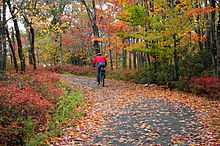Minnewaska State Park Preserve




The Minnewaska State Park Preserve is a 21,106 acre (8,541 ha) preserve located on the Shawangunk Ridge in Ulster County, New York on US 44/NY 55, five miles (8 km) east of New York State Route 299. The park is managed by the Palisades Interstate Park Commission. It is primarily used for picnicking, hiking, mountain biking, snowshoeing and swimming. There are outstanding views of the nearby Catskill Mountains. There are three sky lakes within the Park Preserve: Lake Minnewaska, Lake Awosting, and Mud Pond. Lake Minnewaska is roughly a mile long by a quarter-mile at its widest point. Lake Awosting is roughly twice as large.
History
Originally part of Albert and Alfred Smiley's Mohonk Mountain House property, the Minnewaska Mountain House, or Cliff House, was built in 1879 overlooking Lake Minnewaska; it could accommodate 225 guests. After managing and developing Mohonk's early growth for ten years, twin Alfred H.Smiley purchased and developed Minnewaska separate from Mohonk, but brothers exchanged courtesies to each other's guests. A second hotel, Wildmere, accommodated 350 guests. In 1955, Kenneth B. Phillips, Sr., the Minnewaska general manager bought the property from the Smiley family. Cliff House was abandoned in 1972 due to maintenance costs; it burned to the ground in 1978. Wildmere closed in 1979 and burned to the ground in 1986. After years of wrangling over commercial development proposals and lawsuits to block development, New York State bought the property in 1987 and opened the Minnewaska State Park Preserve in 1993. A significant expansion of 5,400 acres (2,200 ha) occurred in 1996 when the Open Space Institute transferred acreage to the Park Preserve from the old Ellenville watershed lands, now called Sam's Point Preserve, currently managed by the Nature Conservancy and owned by the Open Space Institute. Located within the Minnewaska State Park Preserve and neighboring Mohonk Preserve is the Trapps Mountain Hamlet Historic District, listed on the National Register of Historic Places in 2000.[1]
Recent expansion
In March 2006, an additional 2,500 acres (10 km2) were added to the Preserve as a result of action by a coalition of conservation groups including The New York - New Jersey Trail Conference, The Open Space Institute, and The Nature Conservancy. Their success was made possible in part because the real estate partnership that sought to develop the property collapsed due to an internal financial dispute. To settle this dispute among the partners, a court ordered that the property be sold.
Ecological characteristics
Unique communities such as Ice Cave Talus , Pitch Pine-Oak-Heath Rocky Summit , and extensive Chestnut Oak Forest comprise Minnewaska State Park Preserve. These ecosystems host a variety of plants and animals that are uncommon in New York State. Wildlife such as the Timber Rattlesnake (Crotalus horridus), Bobcat (Lynx rufus) and New York State's only documented occurrence of the noctuid moth Zale curema reside within Minnewaska State Park Preserve.
Swimming in Lake Minnewaska
Swimming was allowed throughout the entirety of Lake Minnewaska and surrounding Lake Awosting and Peterskill areas until 1987 when New York State purchased the land and closed the lake to public recreation. In 1988 under the guidance of Helga Schwartz and through numerous petitions, swimming was reinstated in a small roped off area.
On April 19, 2000 Judy Mage, Myriam Miedzian, and Ellen James met with Park officials and the PIPC (Palisades Interstate Park Commission) to present proposals for the allowance of distance swimming on the lake. As a result of this meeting the designated swim area in the lake was increased and the closing time for swimming was extended by half an hour.
On June 11, 2000 SWIM (Swim Without Interference at Minnewaska) was created to attempt to bring back swimming throughout the entire lake. After much debate and negotiations with Parks officials, SWIM proposed the formation of a club where members would be tested for swimming ability, purchase insurance cards, and sign release of liability forms. The group was able to secure a second swimming area consisting of a 200-yard buoyed cable that runs parallel to the shoreline for distance swimming.
In the Spring of 2002 SWIM became the Minnewaska Distance Swimmer's Association (MDSA) and signed up 430 members its first year. Currently the MDSA has close to 700 members.
Image gallery
-
The best swimming spot in Lake Awosting
-
A view of Lake Awosting from the cliffs
-
The swimmer's beach at Lake Minnewaska
References
- ↑ "National Register Information System". National Register of Historic Places. National Park Service. 2009-03-13.
External links
- New York State Parks: Minnewaska State Park Preserve
- Lake Minnewaska.org
- Hiking at Lake Minnewaska
- NY-NJTC: Minnewaska State Park Preserve Trail Details and Info
Coordinates: 41°43′12″N 74°17′02″W / 41.72°N 74.284°W


